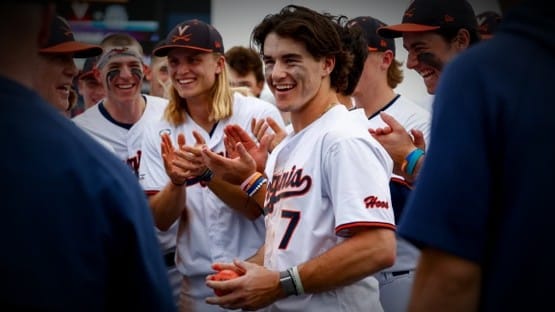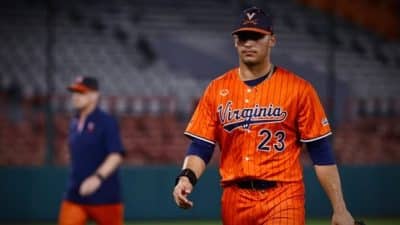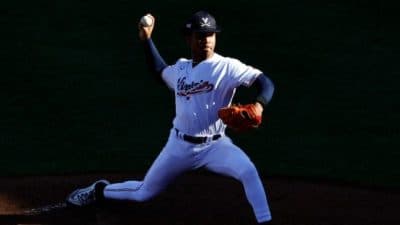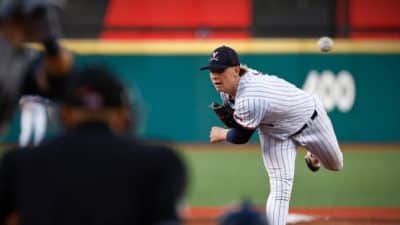
I’m not going to disagree all that often with our new baseball writer, Greg Waters, because Greg Waters, your favorite baseball writer’s favorite baseball writer, has forgotten more UVA Baseball than I’ll ever know, but I’m not quite there with Greg on there being nothing wrong with UVA Baseball, as he posits in his latest deep-dive column for us.
ICYMI
Now, I waited to write this until I wasn’t jumping on the pile, so, three-game series sweep of nationally ranked Stanford, scoring 33 runs in the process, all good.
This one, though, has been bouncing around in my head for the past couple of weeks, at least.
Note: I’ll get to the pitching staff giving up 23 runs in the sweep in a hot minute.
Even with the offense eating at The Dish this past weekend, we’re near the midway point to the season, and the ‘Hoos are slashing .299/.395/.442, with a team OPS at .837, and the offense averaging 7.27 runs per game this season.
The numbers for the back-to-back College World Series teams:
- 2023: .332/.426/.526, team OPS at .952, 8.95 runs per game
- 2024: .336/.427/.575, team OPS at 1.002, 8.98 runs per game
The biggest difference between the two groups is in the power numbers. Virginia hit 116 homers last season, averaging 1.84 per game; this year, through 26 games, we’re at 23, or 0.88 per game, so, less than half last year’s rate.
The individual declines are shocking.
- Harrison Didawick had 23 homers last season; he’s at one, through 85 plate appearances, in 2025. Didawick is struggling all around, slashing .183/.314/.254, for an OPS at .568; his slash line last year was .292/.414/.642, for an OPS at 1.056.
- Jacob Ference had 17 homers last season and slashed .350/.465/.710, for an OPS at 1.175. He has two homers in 76 plate appearances this season, with a slash line at .279/.421/.410, for an OPS at .831.
- Henry Ford also had 17 homers a year ago, slashing .336/.409/.597, for an OPS at 1.006. This season: two homers, a slash line at .364/.415/.467, for an OPS at .882.

Virginia, as a team, hit .336 with a collective OPS of 1.002 in 2024. This year’s group has two guys in the vicinity of those team-wide numbers: Eric Becker (.340 BA/.962 OPS) and Chris Arroyo (.307 BA/1.008 OPS).
What’s going on here? If it’s one guy with numbers in decline, you could chalk it up to injury, but a team-wide decline suggests a philosophical change in approach at the plate that wasn’t taking.
Which gets us to the Stanford series. Beware of the small surprise size, but the slash line for the three-game series was .373/.439/.574, for a team OPS of 1.013, and 11.0 runs per game, which feels much more last couple years-like.
Let’s hope we just saw the offense finally start clicking.
Now, to the pitching side of the ledger, and you wouldn’t believe it based on how it feels things have been going, but the pitching staff has been doing a markedly better job compared to last season.
The 2024 pitching staff had a team ERA at 5.47, which, it’s nothing short of remarkable that O’Connor was able to get that team to Omaha, with a 5.47 team ERA.
This year’s group, through 26 games, has a 4.77 team ERA, which still isn’t what you’d call acceptable for an O’Connor-coached team – his 2021-2023 teams, for instance, all had sub-4.00 ERAs, and, yes, as ridiculous as it seems to even bring it up, the 2011 and 2014 staffs had team ERAs at 2.23 and 2.24, respectively.
Back to the 2025 staff: diving into the fundamentals, the numbers, aside from ERA, are more like 2023 than you’d expect – opponent slugging is .393 (2023: .396), OPS allowed is .763 (2023: .721), and fielding independent pitching is 3.62 (2023: 3.90).
One obvious issue for the staff is the defense that plays behind them. The 2025 staff has already surrendered 36 unearned runs, an average of 1.38 per game; the 2024 staff gave up 49 unearned runs, 0.78 per game.
The defense is also a factor on the batting average on balls in play metric: in 2025, UVA opponents have a .368 average on balls in play; opponents in 2024 had a .336 BABIP.
How much of this is no longer having first-round pick Griff O’Ferrall (four errors on 249 chances in 2024) at shortstop, the most important defensive position on the diamond?
O’Connor moved Becker, who played at third in 2024, over to short ahead of the season, and the results, to this point, are mixed (seven errors on 89 chances through 26 games).
I don’t know how that gets better, other than Becker just getting more comfortable at short as the season plays on.

The fundamentals for the Friday-night starter, Jay Woofolk (2-2, 4.67 ERA, 1.30 WHIP), are better than what we’d seen from him last year – opponent OPS is down sharply (from .844 in 2024 to .671 this season, in large part because he’s cut his base-on-ball percentage from 13.5 percent to 8.0 percent, and opponent slugging from .461 to .352.
Woolfolk is pitching like a guy whose ERA should be in the low-threes or high-twos.
The other weekend starters, Tomas Valincius (2-1, 6.06 ERA, 1.53 WHIP) and Evan Blanco (1-1, 4.96 ERA, 1.78 WHIP), haven’t been, and there’s reason to worry with Valincius, a talented freshman who has been hit hard lately (10.34 ERA in his last four starts), though Blanco has had a couple of good outings (two earned in five innings in starts against Cal and Stanford in the past three weeks).
Bottom line: the offense raked this past weekend, the defense still coughed up five unearned runs in the Saturday finale, which is why we needed late-game heroics to finish off the sweep.
There’s still a lot of room for improvement there.
I like what we’ve seen from Jay Woolfolk. We need Tomas Valincius and Evan Blanco to step up.
I still don’t know that O’Connor has a feel for his bullpen.
It’s a work in progress.










